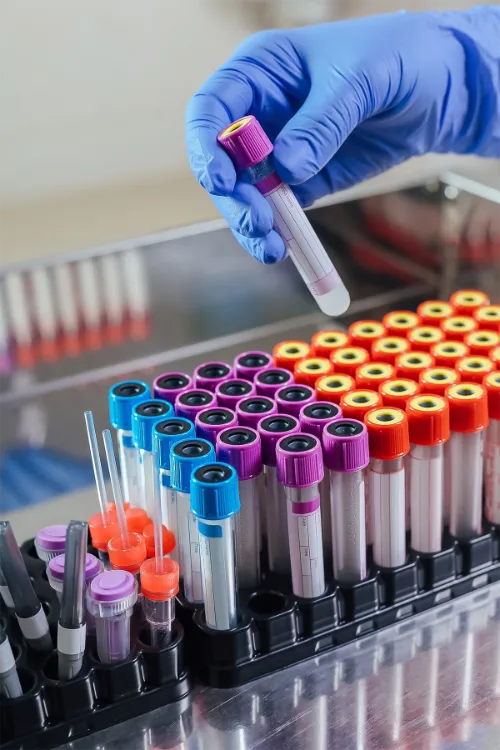Intravenous urography
"This test visualizes the shape of the kidneys and ureters as well as their correct functioning".
DR. LORETO GARCÍA SPECIALIST. RADIOLOGY SERVICE

What is intravenous urography?
Intravenous urography is a special X-ray examination that consists of the injection into a vein of an iodinated contrast that is eliminated through your kidneys and allows the study, by means of X-rays, of these and the excretory tracts of urine, ureters (ducts that leave the kidneys) and bladder. The images obtained will be studied by the radiologist, who will send a report to your doctor.
The images obtained will be studied by the radiologist, who will send a report to your doctor. This test lasts approximately 1 hour. However, it may sometimes be necessary to stay longer to obtain the late X-rays.

When is intravenous urography indicated?
Intravenous urography is indicated when the urinary tract, including the kidneys, ureters and bladder, needs to be studied in detail.
To obtain accurate images, it is essential that the colon is clean, as intestinal debris can overlap the kidneys and make visualisation difficult.
In the days prior to the study, it is important not to have taken contrasts or medications containing barium, bismuth, iodine or other metals, as these may interfere with the quality of the images.
In what cases is it usually requested?
This type of test is usually indicated in situations such as:
- Haematuria (blood in the urine).
- Renal lithiasis (presence of stones in the kidneys or urinary tract).
- Suspected tumours in the urinary tract.

Would you like to know more about this test?
If you would like more information, please do not hesitate to contact our team.
How is an intravenous urography performed?
Test performance
First, an abdominal x-ray is obtained to check that the bowel is clean enough for the test and that there is no gas or intestinal content overlapping on the renal silhouettes.
A venous line is taken and a special contrast is administered that makes the kidneys and urinary system visible to the rays. This will show the radiologist what the anatomical structure of your urinary system looks like and how urine is passed through the urinary tract and into the bladder.
After the injection, x-rays will be taken. You will be asked to hold your breath at some point during the time the x-ray is taken. Once the radiologist has seen your bladder full of contrast, you will be asked to go to the bathroom to urinate and then a final x-ray will be taken with your bladder empty.
It is not a painful procedure although some patients may experience a sensation of heat, cold or a metallic taste after the injection. If you feel nauseated or have difficulty breathing, quickly report this to the technician, nurse or radiologist.
The exam takes about 1 hour. Sometimes it is necessary to stay longer to get the late x-rays.
Preparation the day before the test
- You will try to eat around 2-3 o'clock in the afternoon, taking a diet low in residues: meat, fish, ham, tea and low-sugar juices. You will abstain from bread, milk, fruit, vegetables, legumes and sweets. You should not eat any food during the afternoon and evening.
- After breakfast and lunch, as well as at 10 o'clock in the evening, you will take two chewed "AERO-RED®" tablets.
- At around 5pm you will start taking the "EVACUATING SOLUTION" orally at a rate of ¼ of a liter every 10-15 minutes, until you obtain clear, clean, liquid stools. Its effect begins approximately at the time of beginning the preparation and the amount that will be necessary to drink varies between 3 and 4 liters.
Preparation day of the test
- On the morning of the exam, drink only liquids and do not eat or smoke until after the scan.
- Before going to the exploration, an "ENEMA CASEN®" will be administered through the anal route, this enema will be exploded and, if it turns out to be dirty, warm water enemas will be applied again until they come out clean.
There is no inconvenience in taking your usual medication unless you are instructed otherwise. If you are diabetic, you should consult your doctor.
Allergic reactions
The iodized contrasts, on some occasions, can cause allergic reactions, which are mostly banal (nausea, skin rashes, etc.) and exceptionally can be serious (drops in blood pressure, glottis edema, anaphylactic shock, etc.).
If you suffer from allergies of any kind or have had adverse reactions to the contrasts before, you must tell us in advance even if you have done so before, are included in the history in writing or think everyone already knows; it is for your safety.
Where do we do it?
IN NAVARRE AND MADRID
The Department of Urology
of the Clínica Universidad de Navarra
The Department of Urology of the University of Navarra Clinic offers the patient a medical team, composed of first-rate professionals, and state-of-the-art diagnostic and therapeutic means such as the Da Vinci® robotic surgery.
The Department of Urology possesses the certificate of accreditation of the European Board of Urology, a reinforcement of the excellence of the service at the level of care, teaching and research, which in Spain only three hospital centers possess.
Diseases we treat:
- Prostate Cancer
- Kidney Cancer
- Bladder Cancer
- Testicular Cancer
- Benign prostatic hyperplasia
- Urinary Incontinence
- Renal Lithiasis
- Genitourinary Prolapses
- Pediatric Urology

Why at the Clinica?
- A team of top-level professionals trained in international centers.
- State-of-the-art technology for diagnosis and treatment.
- In 24-48 hours you can start the most appropriate treatment.




































